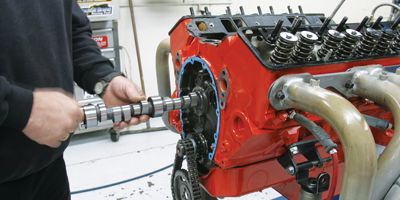
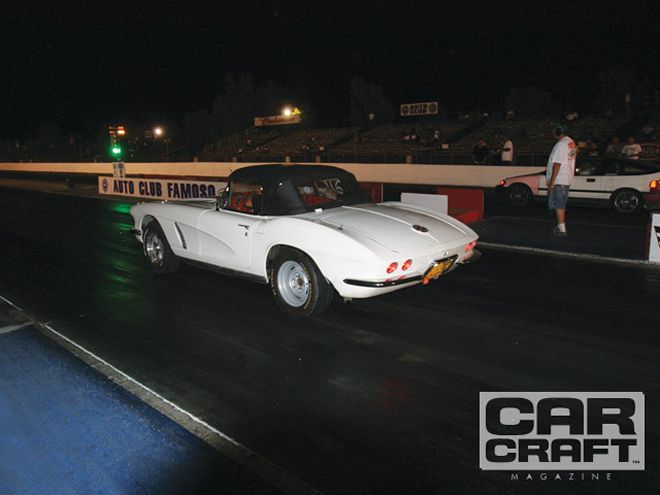 This is a story about how a hydraulic roller cam and a pair of AFR heads were worth more than 70 hp in a real street-driven small-block Chevy.
This is a story about how a hydraulic roller cam and a pair of AFR heads were worth more than 70 hp in a real street-driven small-block Chevy.
Several years ago, we met Wes Migletz and his wife, Winny, driving their '62 Corvette on Car Craft's Anti-Tour to Las Vegas. We thought the Vette was cool because it was owned by a guy who actually thrashed on his car. Plus, Wes and Winny are great people. Then several months ago, Tony Mamo of Air Flow Research called with an idea. Apparently, there had been this lively exchange among Mamo and multiple forum dwellers on a Corvette website with several guys making exaggerated claims about certain cylinder heads. Mamo called them out with a no-bull offer to put up their best stuff against a set of off-the-shelf AFRs. What was interesting was as soon as Mamo made the offer, the string fell strangely quiet.
Migletz had been following this chest thumping for some time, and when no one else took up the gauntlet, he emailed Mamo and said that while he didn't own a C4, he wasn't afraid to abuse his '62. Mamo called us to see if we were interested in following along, and that's when we realized that the guy willing to do all the work was already a hard-core Car Craft reader. The test was as simple as it was labor intensive. Migletz first had to baseline his Corvette on the dragstrip. Next, he had to yank his engine, bolt it up to Westech's engine dyno, and beat on it a little more. First we'd run it with his cam, then swap in a bigger hydraulic roller, and then bolt on a set of AFR 195 Eliminator heads. Then Migletz had to stuff the engine back in the car and twist it again at the dragstrip. Whew! All of this had to be done before Migletz went back into military service in a few short months, which would take him away from his family and the Corvette for an extended time. Listening to the story, we figured if Migletz was willing to do all this thrashing, the least we could do was relay the story. Did we mention the Corvette was already a 12-second car sporting a stroker 395ci small-block fitted with a set of professionally ported 461X heads? Yeah, the baseline was not going to be some lame 305 with stock heads.
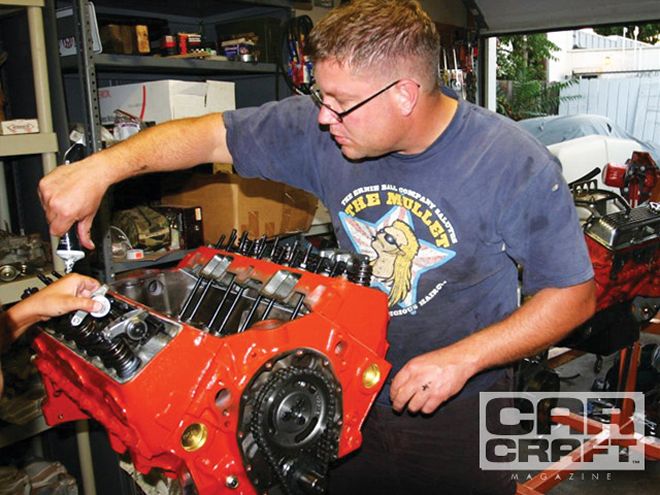 This is a shot of Migletz and his son, Reb, assembling the Corvette's 395ci stroker motor. Originally, the engine had a dual-plane, but he swapped over to the single-plane for the dragstrip testing. Wes recently joined the North West Houston Vette Rod (and Gun) Club. It's entirely possible that you can't have a club in Texas without including guns.
This is a shot of Migletz and his son, Reb, assembling the Corvette's 395ci stroker motor. Originally, the engine had a dual-plane, but he swapped over to the single-plane for the dragstrip testing. Wes recently joined the North West Houston Vette Rod (and Gun) Club. It's entirely possible that you can't have a club in Texas without including guns.
The Car
Migletz is no stranger to early Corvettes. He's owned several, including a '59 he wrecked and rebuilt as well as this '62. The cars are not pristine-they can't be because he's constantly bashing on them. Just before this latest escapade, he and Winny drove the '62 cross-country from California to Kentucky on a main course tour of the Corvette assembly plant in Bowling Green and then accompanied us on CC's little jaunt to Phoenix as dessert.
In its baseline state, the '62 is powered by a JMS Racing-built 395ci small-block that retains its original numbers-matching 327 block (that should throw the purists into near hysteria). He had the block bored 0.040 over to fit Ross 22cc dished pistons and Manley 6.00-inch small-journal steel rods hung on a Callies 3.850-inch steel stroker crank retained by a set of Pro-Gram steel four-bolt main caps. Migletz believes in building torque motors, so the cam in this stroker is a mild solid flat-tappet, single-pattern cam from Camonics in North Holly-wood, California, using 1.6 rockers. Breathing pieces included a Weiand low-rise dual-plane intake with a 750-cfm Carb Shop 0-3310 vacuum-secondary Holley carb and 1 3/4-inch Hooker headers with a 2 1/2-inch exhaust system. The '62 Vette was originally a Powerglide car, although it's now geared with a 700-R4 overdrive spinning a 3.36:1 rear gear. For the baseline runs, he also added a set of Mickey Thompson 26-inch-tall drag radials. After three runs at Bakersfield, the car ran 12.82 and 12.83 at 107.05 and 107.21 mph that revealed its consistency.
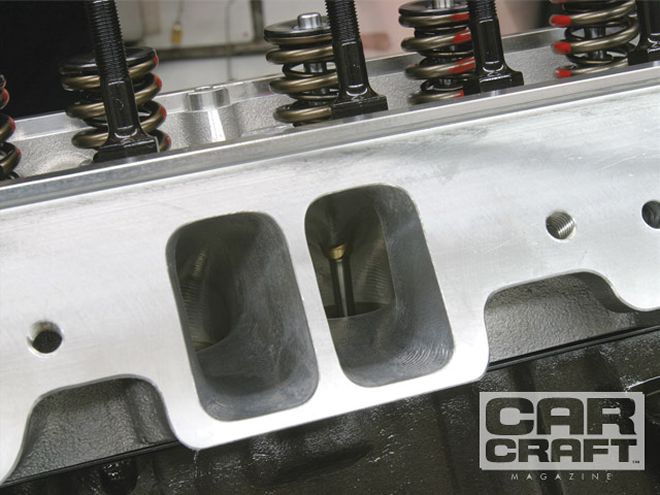 Next on the test schedule was a quick installation of the AFR 195 Eliminator aluminum heads. As you can see from this intake port, there is virtually a straight shot from the manifold right to the valve. Also note these are the competition versions of the AFR heads with full CNC porting of the intake and exhaust ports as well as the combustion chamber.
Next on the test schedule was a quick installation of the AFR 195 Eliminator aluminum heads. As you can see from this intake port, there is virtually a straight shot from the manifold right to the valve. Also note these are the competition versions of the AFR heads with full CNC porting of the intake and exhaust ports as well as the combustion chamber.
The Test
After baselining the car at the track, Migletz pulled the small-block and we bolted it to Westech's SuperFlow engine dyno and began flogging it again. It was clear that the car's 107-mph trap speed indicated it was making good power, and the baseline run with open headers also saw a slight change to a Holley Street HP 750-cfm carb. We did a quick comparison of the Street HP to the vacuum-secondary carb, and at the peak, the difference was around 8 hp, so we went with the HP carb as the baseline horsepower number. As you can see, the motor made a reasonable 447 lb-ft at a torquey 4,100 with 418 for horsepower at 5,400.
Next, we had ordered a more aggressive hydraulic roller cam that would offer up a little more lift than the flat-tappet cam without necessarily adding a ton of duration. This materialized as a Comp Cams XR282HR cam with a slightly wide 112-degree lobe-separation angle to improve the idle vacuum. We also added a set of Comp Cams aluminum 1.6:1 roller rockers to bump the lift to 0.544/0.554 inch. This cam is smaller in duration at 0.050, which belies its intent to really pump up the torque curve while also adding as much lift as possible, even though it is still way short of an ideal 0.600 inch of lift. By changing to a roller cam, we also had to add a button to the end of the cam to limit cam walk, which could retard ignition timing.
Even though the cam appeared to be smaller, the combination of cam and better cylinder heads pushed the peak torque by 600 rpm and horsepower by 500 rpm. This was worth a small increase in peak torque but a major 30-plus gain in peak horsepower, which now jumped to 453 hp at 5,800. This set the stage for the last test on the engine dyno with a swap to the feature attraction AFR 195cc heads. After a short exercise with optimizing jetting and timing, Westech's Steve Brul ran the motor through a complete pull from 2,500 to 6,500 rpm, and above 5,000 was when the big numbers started popping up. At 6,000 rpm, peak horsepower came in at an impressive 490 with peak torque jumping up to 480 lb-ft at 4,900 rpm, offering up a solid 1,100-rpm powerband between peak torque and peak horsepower. Overall, with just a cam and head swap, the 395ci small-block was making a solid gain of 72 hp and 33 lb-ft.
As you can see by the flow numbers, this test began with a pretty good set of heads in the ported 461Xs. We've listed the flow numbers for similar stock 462 heads to reveal what the porting work produced. To put this in perspective, there are several 180 to 200cc aftermarket aluminum heads that don't flow nearly as well on either the intake or the exhaust side as these ported heads. The AFR heads are better yet with a 30-cfm jump on the intake and 31 cfm on the exhaust side at 0.500-inch valve lift. While everyone usually concentrates on the intake side, the large gains on the exhaust are generally what deliver good peak horsepower numbers.
Cylinder Head Flow Comparison Stock 462 Ported 461X AFR 195 Port volume (cc) Intake 156 cc 191 cc 194 cc Exhaust N/A 67 cc 70 cc Cylinder Head Testing Intake Flow Exhaust Flow CFM CFM Heads Stock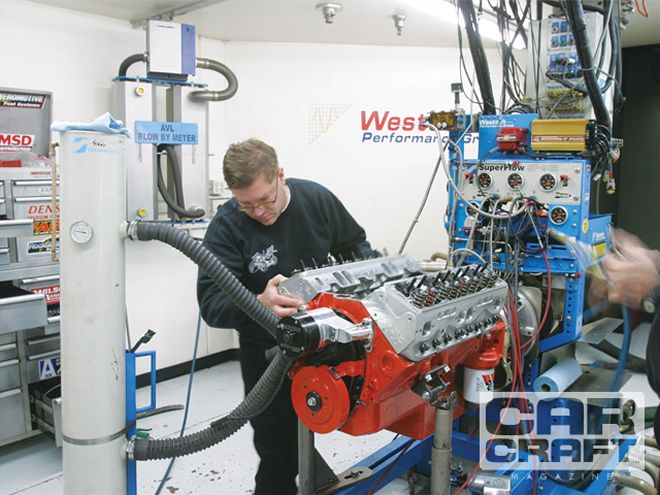 We bolted the heads on in a matter of minutes, and the direct result was a major gain not only in peak power but also in average torque at every rpm point. At the peak, the 395 ci fell just short of 500 hp with 490 at 6,000. Yahoo.
We bolted the heads on in a matter of minutes, and the direct result was a major gain not only in peak power but also in average torque at every rpm point. At the peak, the 395 ci fell just short of 500 hp with 490 at 6,000. Yahoo.
Peaks And Averages
While the dyno graph clearly shows the power increase when we added the camshaft and the cylinder heads, we went one step further and have included the peaks and averages for horsepower and torque from 2,500 to 6,000 rpm. With the bigger cam, Test 2 and Test 3 extended the power beyond 6,000 rpm, but we did not include those numbers to maintain a fair comparison. Note that while the cam improved the average torque by 4 lb-ft, the head swap with the cam added a whopping 27 lb-ft of average torque. That means the torque gained an average of 27 lb-ft at every 100-rpm point between 2,500 and 6,000 rpm. That's an amazing power gain, and this was against an excellent ported head as evidenced by the flow bench test numbers. A 71hp gain at the top is fun to claim on the Internet, but the real point here is the tremendous gain in average power. It's hard to point to just the cylinder heads because that 27 lb-ft is the combination of the Comp hydraulic roller and the AFR heads. But that push is what you'll feel in the seat of your pants.
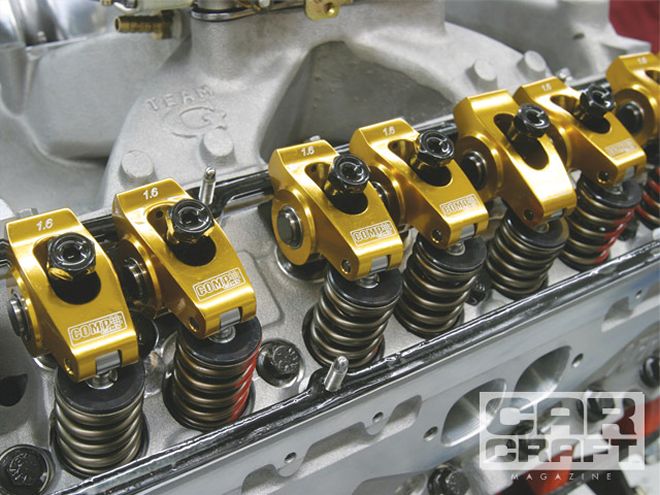 In addition to the hydraulic roller, we added a set of Comp Cams Ultra-Gold aluminum 1.6:1 roller rockers to help pump up the lift. Since these heads will increase airflow well past 0.600-inch lift, we could have used more lift, which might have pushed this small-block above 500 hp.
In addition to the hydraulic roller, we added a set of Comp Cams Ultra-Gold aluminum 1.6:1 roller rockers to help pump up the lift. Since these heads will increase airflow well past 0.600-inch lift, we could have used more lift, which might have pushed this small-block above 500 hp.
Final Test
Rather than rely on just engine dyno numbers, AFR's Mamo also wanted some final dragstrip numbers. If you recall, the Corvette ran 12.82 at 107 mph in its original condition. The return run up at Bakersfield was more than a little disappointing, since the Corvette didn't run any quicker, but the trans automatically upshifted in Drive at a way-too-low 5,400 rpm. This prevented the engine from taking advantage of that additional horsepower between 5,000 and 6,000 rpm. Plus, with the additional torque the new heads contributed, the Corvette now spins the tires on the launch, something the previous combination did not do.
Clearly, there is more to gain with additional track tuning, and just because the engine makes more power doesn't always mean the car will run quicker. This illustrates just how important all the little details are in terms of getting the car quickly down the track. The launch, chassis tuning, tire pressure, shift points, and proper engine tuning all affect how well the car runs down the track. It's all part of the game if you want your car to run quicker. Clearly, Migletz has more work to do, but the Corvette is on its way to the low 12s.
Click here for the small-block dyno chart.
PARTS LIST Description PN Source Price AFR 195cc Eliminator, pair 1095 AFR $2,079.00 AFR 195cc not ported, pair 1034 AFR $1,510.00 Comp Cams XR282HR 12-432-8 {{{Summit}}} Racing $265.95 Comp Cams hydraulic lifters 853-16 Summit Racing $435.75 Comp Cams pushrods 7609-16 Summit Racing $99.95 Comp Cams aluminum rockers 19002-16 Summit Racing $239.75 Weiand Team G intake 7530 Summit Racing $193.95 Holley Street HP 750 carb 0-82751 Summit Racing $483.75